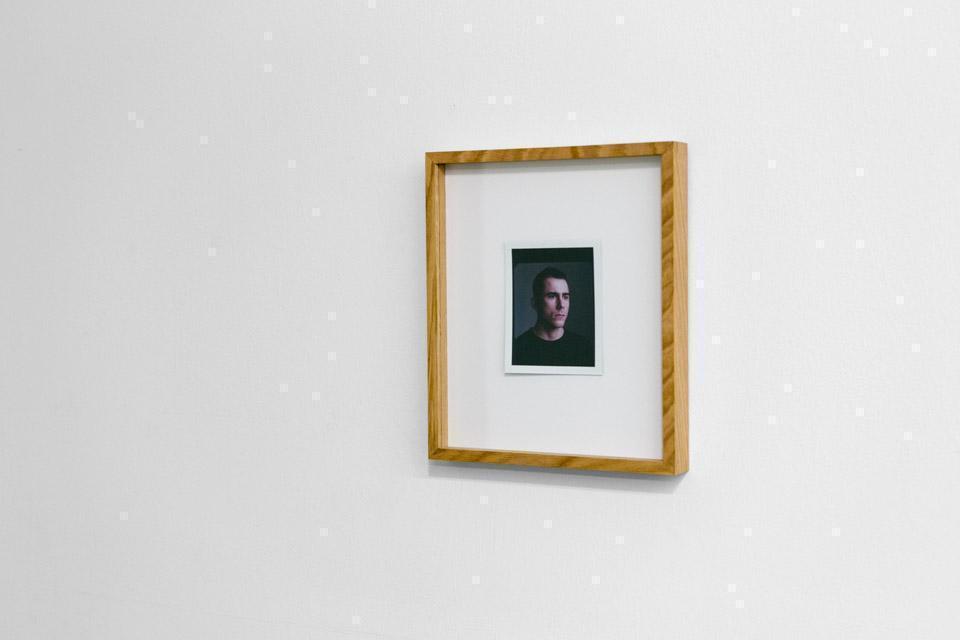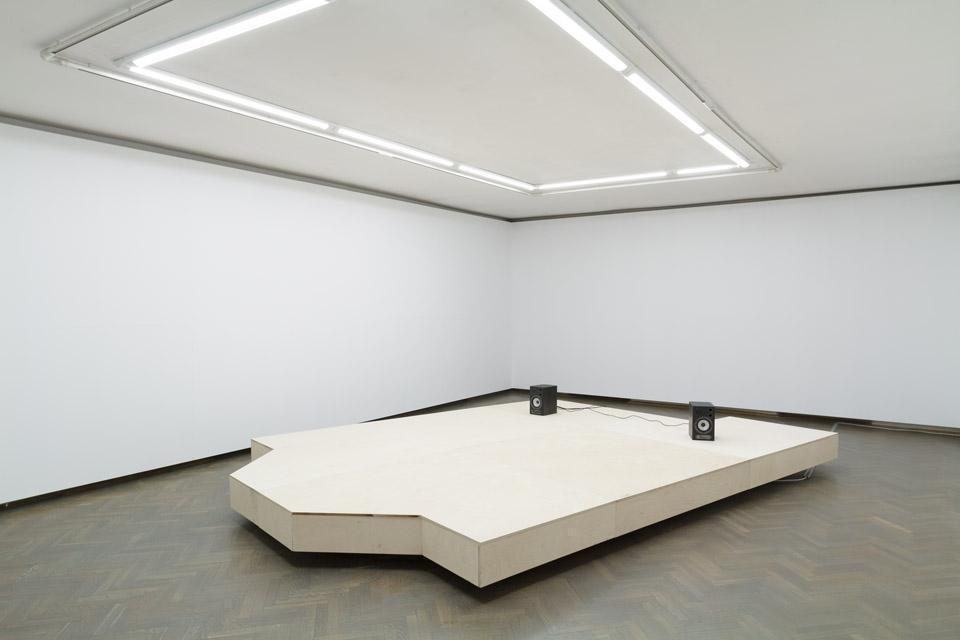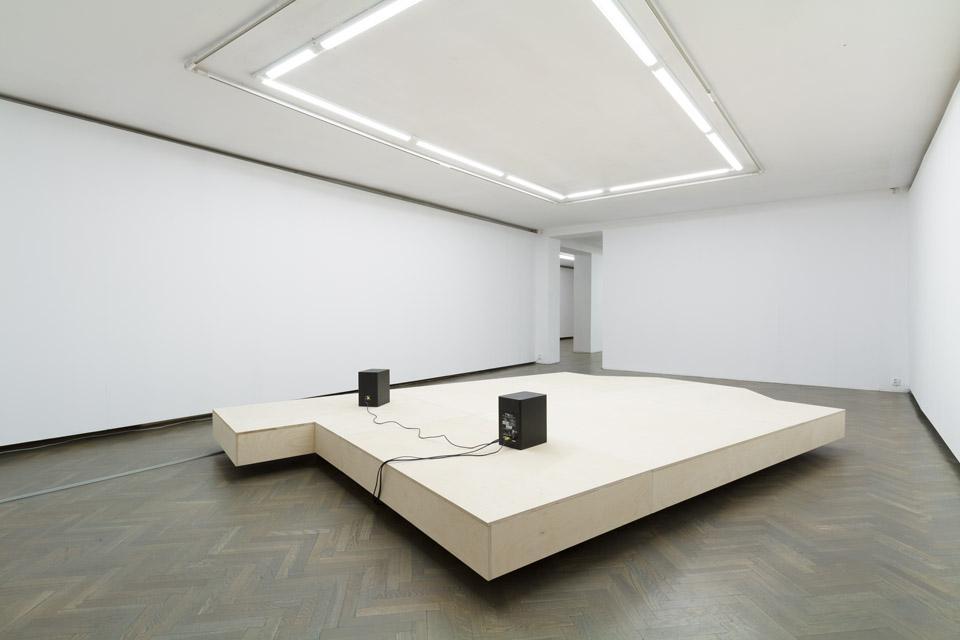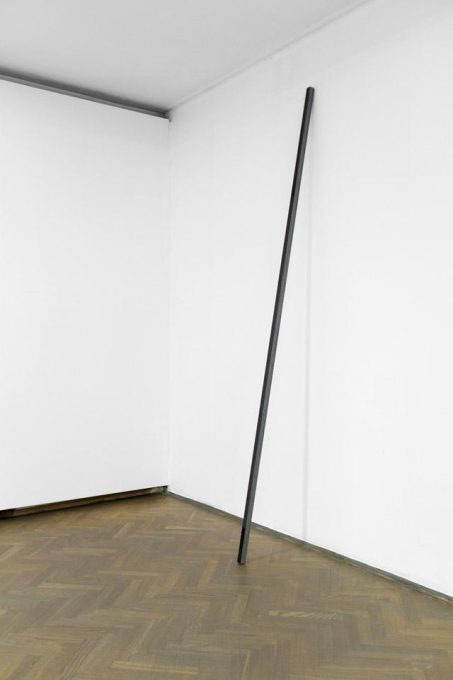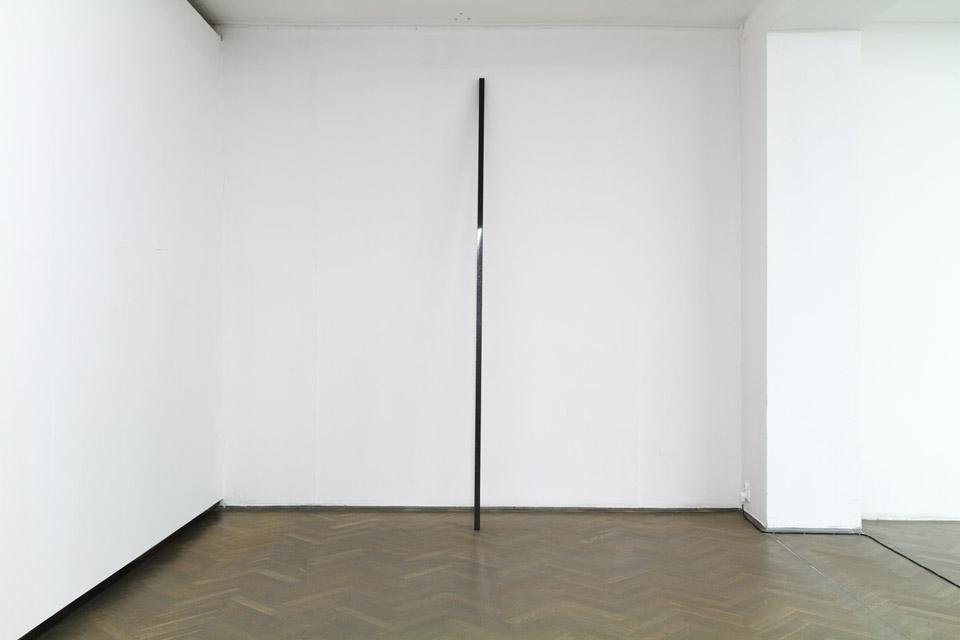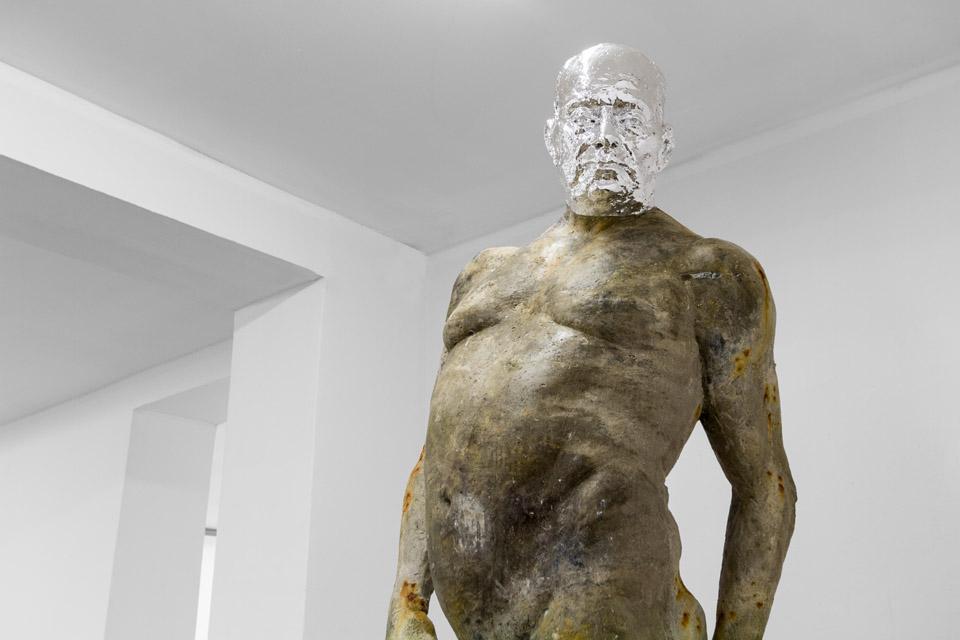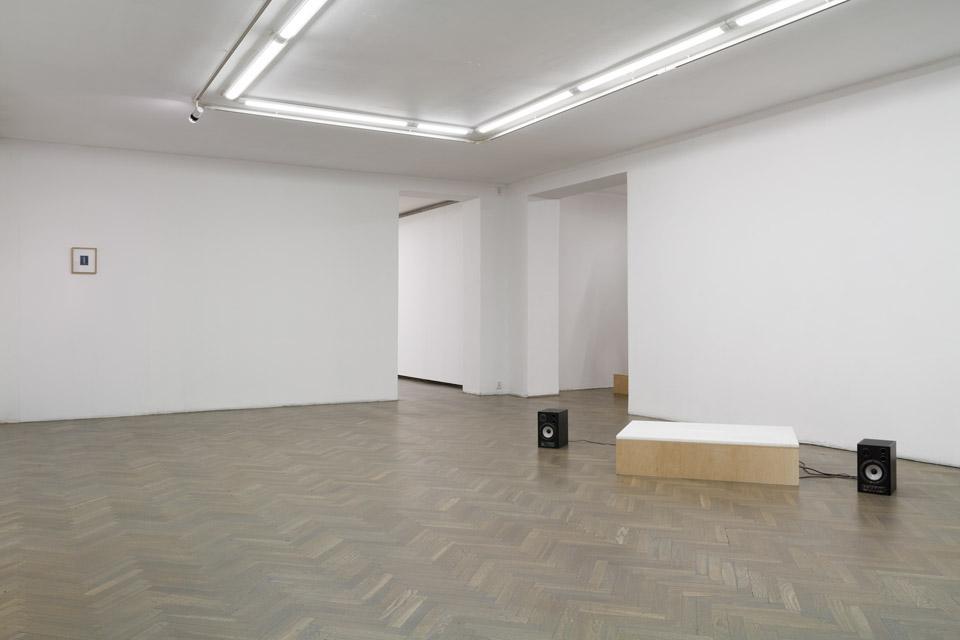MATEUSZ CHORÓBSKI. I was maddened with sunlight. I felt like laughing
Jakub Śwircz
Regarding the exhibition “I was maddened with sunlight. I felt like laughing”
Themes that constantly recur in the works of Mateusz Choróbski may invite the search for signs of the Romantic approach in his output. The scale, revealing Choróbski’s peculiar heroism, is certainly one of those. He has often placed his individual gestures in opposition to some larger whole, for instance inThe Draught (2013), where he had arranged a jet plane to fly just above Piotrkowska street in Łódź, orThe Loneliness of the Long Distance Runner(2014), when together with Anna Orłowska he transformed the night-time life of Katowice into a radio drama available to internet users with a black long distance runner as the actor. Another theme inviting this interpretation of Choróbski’s approach is his interest in ruins, fragments, traces and remains, which is evident, for instance, in his work TheLong Delayed Reunion(2012), in which he investigated the ruins of his grandfather’s photographic studio.
Choróbski’s withdrawal into the background is a factor that completes this approach and gives it a contemporary character. Despite being the initiator or creator of those actions, he provides some space for chance, the force majeure or third-party participation in them. He prefers to watch the mechanisms he has set in motion and to feel their influence on himself. Changes and reactions he seeks are as ephemeral as the trace of a jet in the sky and the whispers of astonished passers-by. There is little power, force and revolutionary fire in this, although even the already-mentioned scale might inspire some more rebellious acts. The aggression which smoulders in these works is unrealised; it remains a potential to be consumed by the often accidental recipients.
Choróbski’s romanticism feeds on the contemporary powerlessness to bring about real change, on the fragmentation of the society, the lack of solidarity or the feeling of community, and the hunger for durable materials. Yet these widespread deficiencies do not result in works that would be melancholic or blindly enthralled by the past; Choróbski’s works are perfectly capable of finding their own place in the present-day fluidity and they highlight it.
An interest in memory, and so in the past itself, is a paradox that inevitably results from this contemporary instability. This interest is revealed through attempts to memorise or catalogue memories, attainments and events, as well through constant references to them in the all-embracingimages trouvés. There are certainly many reasons for this, for instance the destabilisation of chronological order, which since the Enlightenment was disciplined by the past, the present and the future. Today, it is increasingly easy to enter the past, to imitate or counterfeit it, and to include it anew in disjointed narrations; to take a piece of a Greek marble and treat it as another element of a contemporary collage.
Before he began working on the exhibition “I was maddened with sunlight. I felt like laughing”,Choróbski visited the Pergamon Museum in Berlin. His visit occurred at a very special time, just as the five-year refurbishment of the museum was to begin. Most of the collection of ancient sculpture had already been packed, subjected to hibernation and awaited transport to storage rooms. Covered with protective wrapping, the marbles looked as if they were being readied as models for moulds. In the Pergamon Museum, an attempt at imitating, or, to put it better, deforming acquires a very particular meaning, as this institution itself was founded on similar principles. Built in order to hold, among others, the reconstructed Hellenistic altar of Pergamon, it consists of reconnected and remounted fragments of ruins. It is full of traces and replicas of artefacts that were transferred to an empty space that constituted a scenery prepared so that the contemporary viewers could scrutinise these remains and measure themselves against them.
This heterotopic scenery perfectly conveys that fluidity of our age. In Choróbski’s approach, it is also a formatting one, as it reveals not only the contemporary confusion from which his romanticism may spring, but also the backstage aspect of art understood as an artificial creation brought forth from reality. Bound with webbing and wrapped in protective foam, ancient sculptures were turned into manoeuvrable, easily moved pieces of a puzzle; Choróbski would remember them while working on the exhibition “I was maddened with sunlight”.
Reminiscences have a vast significance to Choróbski himself, too, and we could risk the opinion that this is exactly what the exhibition consists of. Hence he, too, joins in this fixation on the past. But, having passed through the workshops of Mirosław Bałka and Krzysztof Wodiczko, he knows that human memory may be, or in fact always is, fallible, burdened with the very possibility of forgetting. Memories change and grow blurred; they grow together with their bearer like a garment that has to be patched and lengthened with each centimetre acquired. And it is precisely of such stitched and pieced elements of matter that Choróbski’s exhibition consists.
It opens with a Polaroid portrait of the artist gazing straight ahead, with the irises of his eyes painted in blue. This colour evokes many associations, beginning with the fact that it was ascribed to Zeus, the patron of the Pergamon Altar. Yet the memoires of what the artist has seen continue on and on. They include Derek Jarman’s film Blue that was his farewell to his loves ones as much as to the diminishing eyesight, as well as the sadness and melancholy of which blue is the symbol. These are followed by yearning and its embodiment, Maurice Maeterlinck’s play The Blue Birdtelling of the siblings Tyltyl and Mytyl’s search for the titular fabulous creature; to find it, they had to prove the purity of their hearts and souls. When Choróbski was a young boy, his father drove a Bluebird.
Choróbski’s doubts regarding the world coincide with a kind of childlike naiveté or a longing for something beautiful and untouched. The blue bird is invisible, yet Choróbski lets his audience hear it. The voice of a young actress is heard in the exhibition room, reciting texts from title cards of the 1918 silent film that was the first cinematic adaptation of The Blue Bird. Significantly, when the title-card text is compared with the text spoken by the young woman, a range of changes introduced during the recitation is instantly noticeable. This is because a remembered text is altered and adjusted to the person who recites it. They undergo the process of transformation together.
A large flat object 25 cm high, made of rough plywood and raised on industrial casters,constitutes another patch or trace of Choróbski’s memory. Movable from place to place, it is a repetition of the plan of a room in which Choróbski lived in New York. The height of the object (not including casters) is equal to the height of his own body measured when lying flat on the floor. Similarly to the self-portrait, this work is a signal of his artistic self-absorption, the process of looking at himself in an unspecified period of time. This self-reflection brings back the issue of scale, in which time, so difficult to measure, is assumed as the opposite point on the axis.
A nearly life-size statue of a male constitutes another allusion to things encountered by the artist on his path. It seems to recall the old order, a point of reference for the failing memories. It is a distant echo of the visit to Berlin, but also a revealing example of the process of formation, because Choróbski introduced a significant change in comparison to the original form of the sculpture: he adjusted it to himself. The head of the statue is covered with a mirror coating reflecting the face of the viewer; in the first moment, this was the face of the artist. This effect is a reference to the often encountered sight of the surface of statues or tourist attractions being rubbed through or polished smooth, buffed by thousands of hands stroking the same point, year after year, their trace visible only when layered.
Choróbski’s idea is for “I was maddened with sunlight” to be a kind of a backstage area, revealing what in results, finales and achievements is usually concealed. It is therefore a penetrating look at traces, at the beginnings and processes that constitute realised projects. If earlier in his actions the artist was withdrawing from the foreground, here he invites his audience backstage, where instead of ruins there are only shards and fragments of whatever inspires the foreground.
These remnants are also the building blocks for the interpretation, and thus a reconstruction, of the reasons, decisions and desires. At the Arsenal Gallery in Białystok, it is possible to see the ferment and the material in the process of assembly. The exhibition constitutes Choróbski’s reflection on how that ferment is shaped. Thus, while earlier he could be perceived as a contemporary Romantic whose thought evinced a considerable affinity to that of Cyprien Gaillard, with “I was maddened with sunlight” his approach is enhanced with the interesting aspects of a journey and a flâneur’sdistance towards the fluidly combined places and events that he passes by.
Blue was the last basic colour to be acquired by means of a synthetic process.
translated from Polish by Klaudyna Michałowicz
Mateusz Choróbski was born in 1987 in Włoszczowa, Poland. He received a bachelor’s degree in photography from the University of Arts in Poznań (2011) and a master’s degree in media arts from the Academy of Fine Arts in Warsaw (2013). He achieved further expertise in multimedia thanks to the inter-university cooperation between his home institute and the Fryderyk Chopin University of Music in Warsaw (2011–2013). He was granted a scholarship of the Minister of Culture and National Heritage (2014), the Minister National Education (2012) and theMarshal of the Łódź Voivodeship (2012). In the ranking published by Obieg magazine (Centre for Contemporary Art in Warsaw) he was listed as one of the 11 most promising young Polish artists in 2014.
His works have been shown in individual exhibitions, which include: Blue Bird in Zona Sztuki Aktualnej in Szczecin (2015), I was maddened with sunlight. I felt like laughing in the Arsenal Gallery in Białystok (2015), The Draught in Another Vacant Space in Berlin (2013) and Long Delayed Reunion in Asymetria Modern in Warsaw (2013); as well as group exhibitions such as: Gateways in KUMU in Tallinn (2011), Precipitations in Another Vacant Space within Berlin Art Week (2014), The Loneliness of the Long Distance Runner in BWA Katowice, with Anna Orłowska (2014).
Media patrons:

Mateusz Choróbski
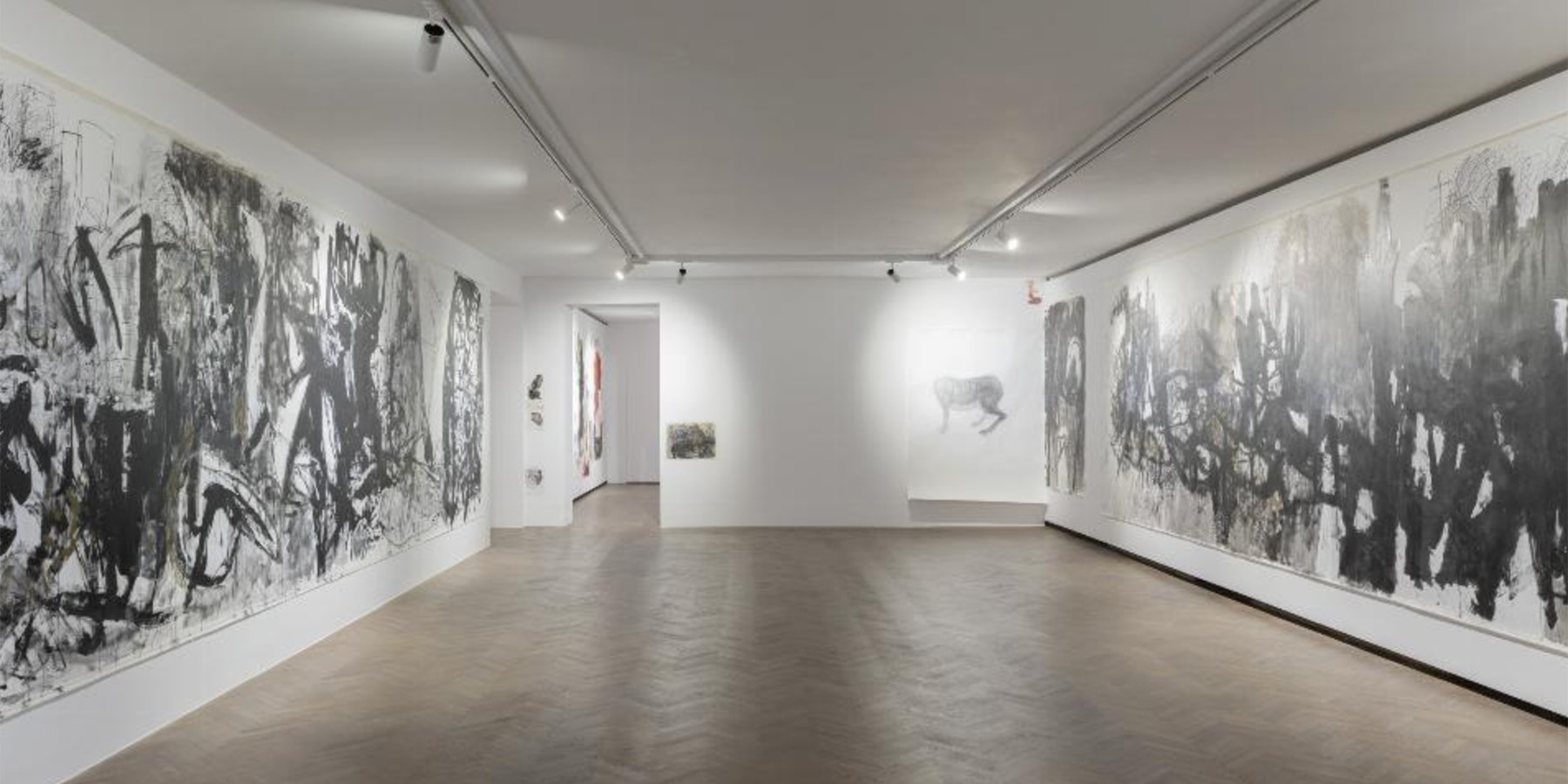
PLAN YOUR VISIT
Opening times:
Thuesday – Sunday
10:00-18:00
Last admission
to exhibition is at:
17.30
